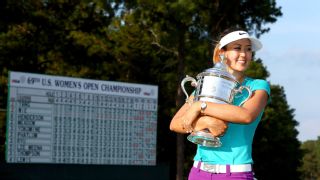When Jordan Spieth rounds Amen Corner this weekend and begins making his way back to the clubhouse at Augusta National Golf Club, the world will be watching as he tries to defend his 2015 Masters title. A short distance away, through a thick curtain of magnolia trees and across Rae's Creek, lies the ninth fairway at Augusta Country Club, where for nearly three decades, until 1966, the best women's golfers played the first major of their season, the Titleholders.
The tree line and creek separating the courses act as a metaphor for the seemingly insurmountable distance that separates the financial compensations for the best male athletes in the world and their female counterparts. Three weeks ago, Novak Djokovic questioned equal pay in tennis. Last week, players on the U.S. women's national soccer team turned to the law to fight for equality. Last Sunday, Lydia Ko won the LPGA's first major, the ANA Inspiration in Rancho, Mirage, California, and received a $390,000 check. It was 21.6 percent of the $1.8 million Spieth earned for his 2015 Masters victory.
Why is the divide so wide in professional golf? There's a lot of history.
From 1937 until 1966, the pioneers of women's golf starred on the early Donald Ross design at Augusta Country Club, but they competed for a fraction of the prize money that the men played for on the other side of the creek. In 1947, Babe Didrikson Zaharias won the Titleholders and took home $300 -- a mere 12 percent of the $2,500 that Jimmy Demaret got for winning the Masters seven days later.
"I was the leading women's money winner for 1948 and my winnings totaled just $3,400," Didrikson wrote in her memoir. "As you can see by that, the amount of [events] available to a woman golf pro was still pretty limited."
In 1950, frustrated by small purses and too few tournaments, Didrikson and 12 other women golfers formed their own tour, the Ladies Professional Golf Association (LPGA). Fourteen years later, in 1964, a year after JFK signed the Equal Pay Act into law to end pay discrimination based on gender, things had actually taken a step back. Marilynn Smith, one of the LPGA's founders, won the second of her back-to-back Titleholders championships and was awarded $1,300, 6.5 percent of the $20,000 Arnold Palmer won two weeks earlier at the Masters.
The pay gap was not restricted to Georgia, either. The United States Golf Association, which runs the men's and women's U.S. Opens, also valued men more. That July, Mickey Wright, then the No. 1 professional female golfer in the world, won the U.S. Women's Open at San Diego Country Club. The United States Golf Association wrote her a check for $2,090, 12.3 percent of the $17,000 prize it gave Ken Venturi for winning the men's U.S. Open.
Neither time nor federal law has helped much. In 1972, Title IX was passed to create equal opportunity and funding for men's and women's collegiate athletic programs. That year Susie Berning won the U.S. Women's Open at Winged Foot in Mamaroneck, New York. Her $6,000 prize was 20 percent of the $30,000 that the USGA awarded Jack Nicklaus for winning the 1972 men's U.S. Open.
But 25 miles south of Winged Foot and one sport away, a world of change was going on. In 1973, Billie Jean King helped gain equal pay for women at tennis' US Open, and by 2007 all four tennis majors were on board with supporting humanity and common sense.
"People are starting to understand there is growth potential throughout all phases of business if you are inclusive and make an honest effort to involve all genders equally," King said to espnW. "This has been a proven success in tennis, is something golf is now looking at and generally is the direction our society is headed."
Let's just say the USGA has moved much slower and not far enough. By 1978 it had raised the purse at the Women's Open to 33 percent of the men's. Eight years later, in 1986, women won 43 percent of what the men did. But over the past 30 years, things have stalled and the gap has shrunk by just 2 additional percentage points.

Two years ago, the USGA held both the men's and women's U.S. Opens on the same course, Pinehurst No. 2, on back-to-back weeks. All told, more than 340,000 fans attended. Michelle Wie's first national title came with a prize of $720,000, which was 44.4 percent of Martin Kaymer's paycheck of $1.62 million from a week earlier.
If not for that one pesky chromosome, Wie could have been in line for an additional $900,000.
Last year, the U.S. Women's Open at Lancaster Country Club in Pennsylvania set a record with 134,016 spectators. Due to the capacity limits at the men's U.S. Open (Chambers Bay could only hold about 30,000 daily) 14,000 more fans watched the women in person than the men. But when Spieth won the men's event with a four-round score of 275, and In Gee Chun won the women's tournament with a 272, the USGA awarded Chun $810,000, 45 percent of the $1.8 million it signed over to Spieth.
Why?
Ratings? Sponsors? Broadcast dollars?
Yes, sure, of course. All of the above.
More skill? Better scores? Harder work?
Nope, not really, of course not.
In 2013, the last year in which both organizations' tax documents are available, the PGA Tour Inc. brought in $1.075 billion in total revenue with $364.8 million coming from TV rights and an additional $290 million from sponsors. That same year, the LPGA earned $102.8 million in total revenue, with $14.6 million coming from TV and $5.8 million from sponsors. But the PGA Tour does not currently run a women's event and the PGA of America has been running only one, the former LPGA Championship, and for only one year. The LPGA, the PGA Tour, and the PGA of America are each separate organizations.
And the USGA also stands as a different entity. Like the other three, it is a nonprofit that must reinvest all revenue, less expenses, back into its cause. The USGA's mission statement, in part, reads that it "acts in the best interests of the game for the continued enjoyment of those who love and play it." Is it not in the best interest of many "who love and play" the game to institute equal pay at the U.S. Open, this country's national championship?
Tax documents show that as of 2014 the USGA had $309.3 million in total assets and made $64 million in profit from 2011 to 2014. The documents do not show how that money was spread out across the organization, but in 2015 the men's U.S. Open purse was increased by $1 million, while the women's was bumped $500,000.
By that logic the men surely must be twice as good. But take an average of the top 10 in scoring and in birdies on both tours you will find that the best men and the best women on the planet play the game equally. The top 10 players in scoring average on the LPGA Tour are shooting a 69.76 per round and the top 10 in birdie average are making 4.36 per round. The top 10 in scoring on the PGA Tour are firing a 69.34 per round and the top 10 in birdies are dropping 4.61 every 18 holes. The men are longer off the tee; the women are more accurate. The men are better from the sand; the women hit more greens in regulation.
They play the same number of holes. They've worked equally hard. Yet the USGA values the men's U.S. Open champion more than twice as much as the women's.

Oddly, the USGA values the women's and men's U.S. Amateur champions equally -- with a trophy and the honor of representing the United States as its national champion for the year. But things shift when a golfer turns professional. Work your body, mind and heart and become the best for that day, for that week, for that year and -- the USGA says -- a woman's victory is not equal to a man's.
Equal pay in golf is not about the number of zeros on the giant cardboard check, just as it wasn't in 2007 when Wimbledon became the final major in tennis to establish equal pay. It is about the message it sends to kids. It sails from the boardroom to the 18th green.
"The USGA takes the lead on so many things," said Smith, one of three living founders of the LPGA. "They could take the lead and have the prize money be the same for the men and women and then they would be doing something very special."
The purse at last year's U.S. Women's Open was the largest in women's golf at $4.5 million. A USGA spokesperson said it is "appropriate for the prominence of the championship, and reflects our desire to attract the greatest players in the world. It also recognizes the worldwide prize money landscape in women's golf, which is correlated to the overall revenue generated by women's golf tournaments."
The USGA would not share a breakdown of the financials for individual tournaments, but it reported $103 million in revenue from its 2014 championships. That same year it spent $42 million on salaries, $4.4 million on tents, $1.6 million on "transportation services" and another $1.6 million on generators at Pinehurst alone. In 2013 the USGA signed a 12-year $1.1 billion TV deal with FOX, which started in 2015. That is more than $92 million a year for the rights to televise the USGA's championships, including the men's and women's U.S. Opens.
The money is there. So is the opportunity to grow the game.
The PGA of America and the PGA Tour have demonstrated that they recognize the prospect of new markets and new revenue streams by partnering with the LPGA. The PGA Tour recently announced an "alliance" with the LPGA that will include the PGA Tour negotiating both the men and women's TV rights to maximize exposure, leverage, and the opportunity to plan joint events.
In 2014 the PGA of America partnered with the LPGA and KPMG to run the former LPGA Championship, what is now called the KPMG Women's PGA Championship.
"People are the most valuable resource in the world and women represent half the population," King said. "There are so many positive reasons for the PGA and the LPGA to get together, but the most important is that they are much more powerful together than they are apart."
Ted Bishop, then president of the PGA of America, (who was fired for a sexist tweet late in 2014) said in a joint statement at the time of the announcement that they would use the tournament as a way to "focus on the advancement of women." They raised the purse 35.7 percent from $2.25 million in 2014 to $3.5 million in 2015.
"It is an example of the long-term commitment our organizations have made to elevate women's professional golf," a PGA of America spokesperson wrote in a statement to espnW. But despite the raise, the KPMG Women's PGA Championship's purse of $3.5 million is only 35 percent of the men's 2015 PGA Championship purse of $10 million.
The disparity extends across the Atlantic, where last year's Ladies British Open purse was worth 30 percent of the men's.
We don't pay top athletes less because of their race or eye color, why is it OK to pay a woman less for winning the same national title? Can you explain that to your kids while you watch Spieth tee off on the 13th at Augusta National? Can you see the ninth fairway, just through the trees?

